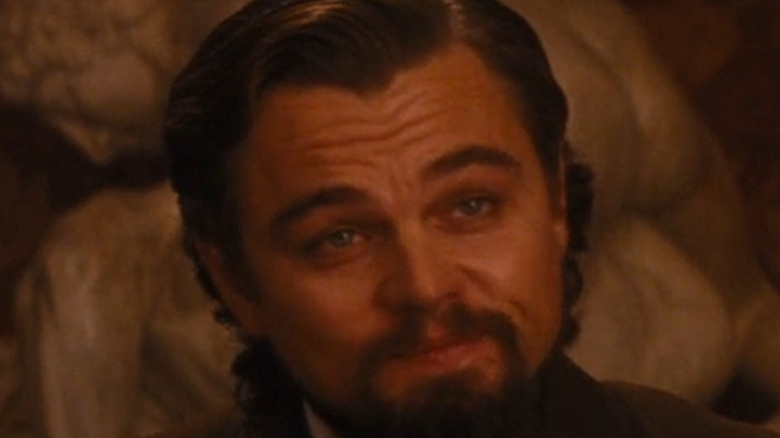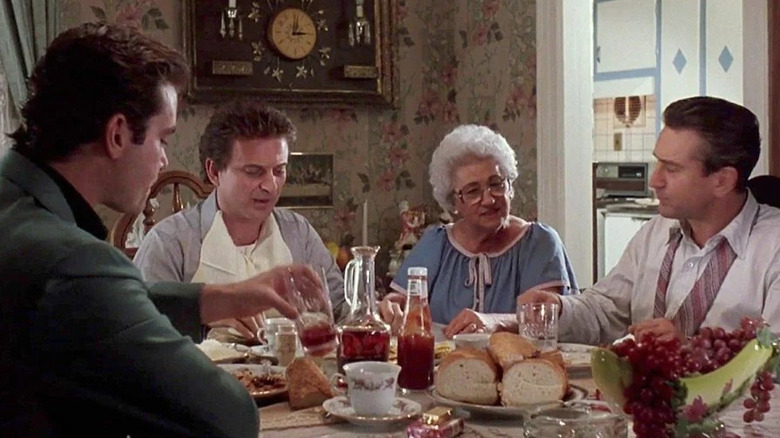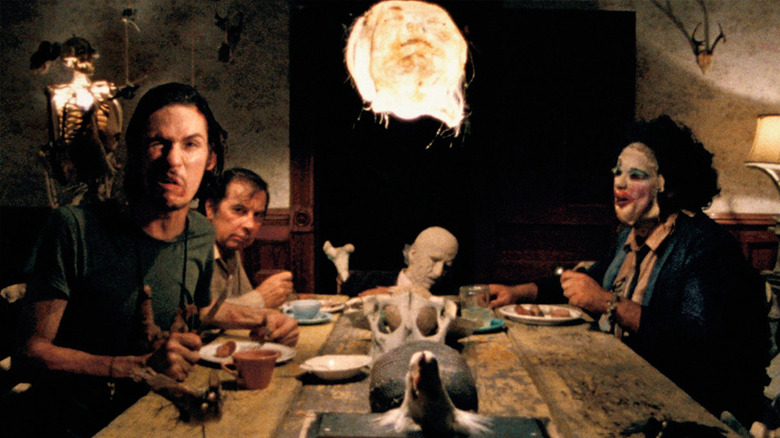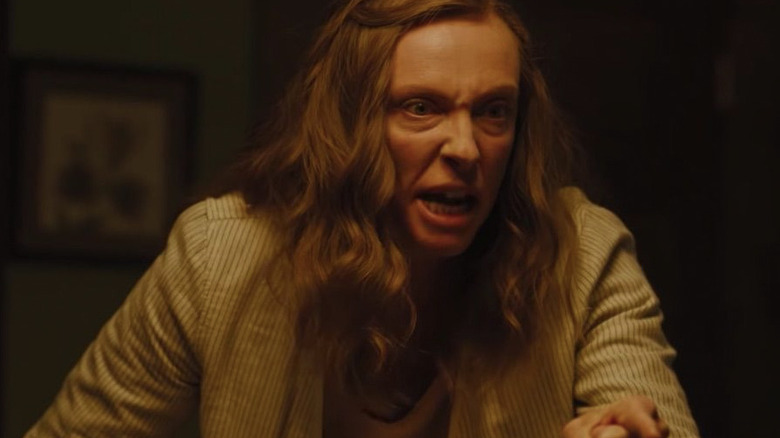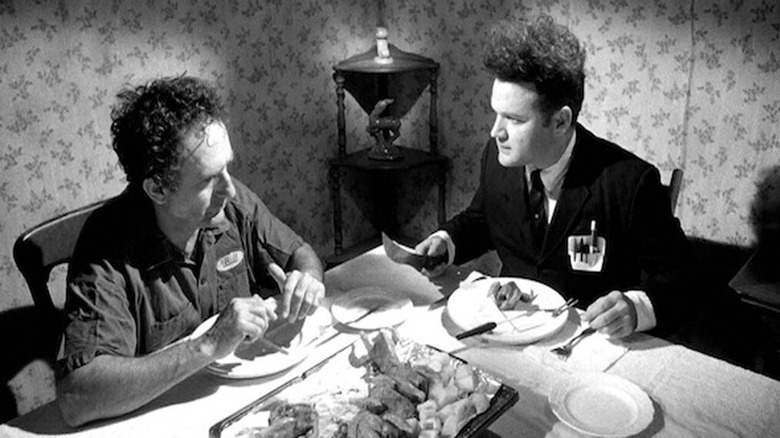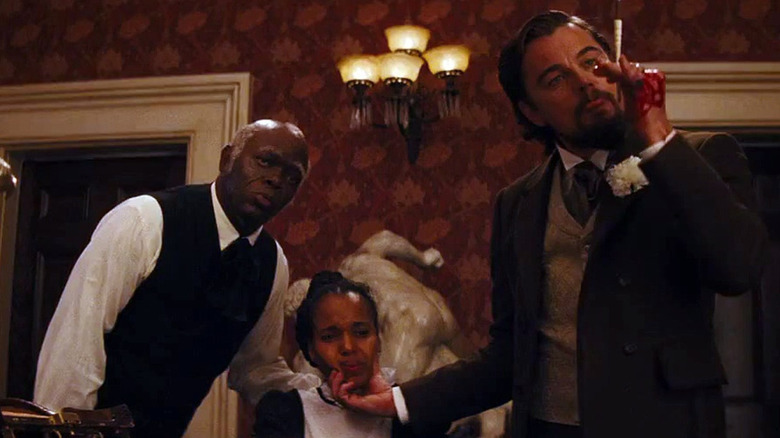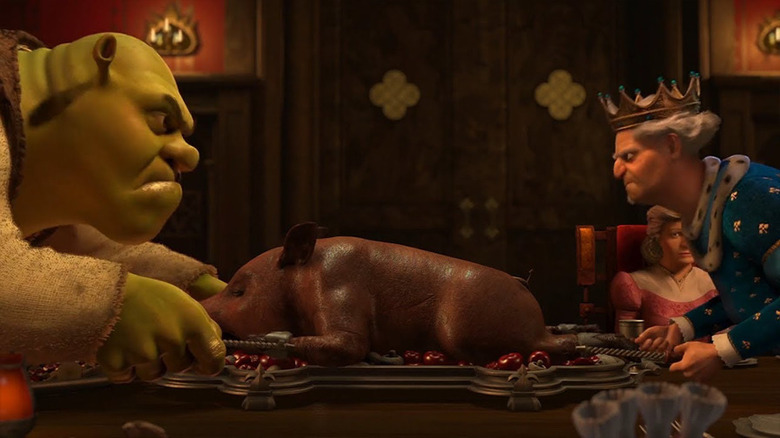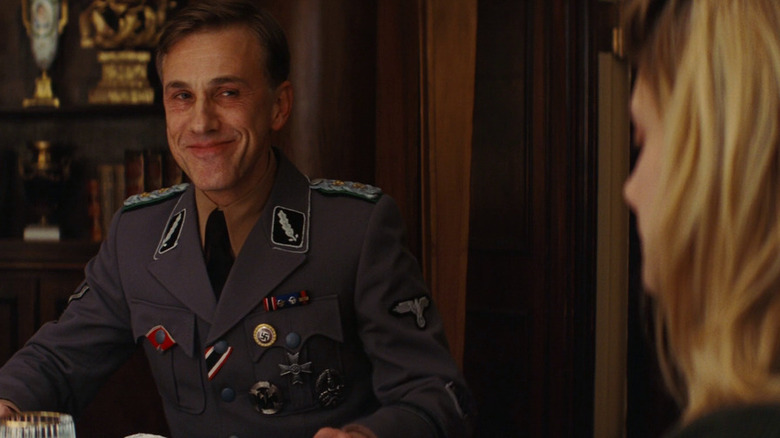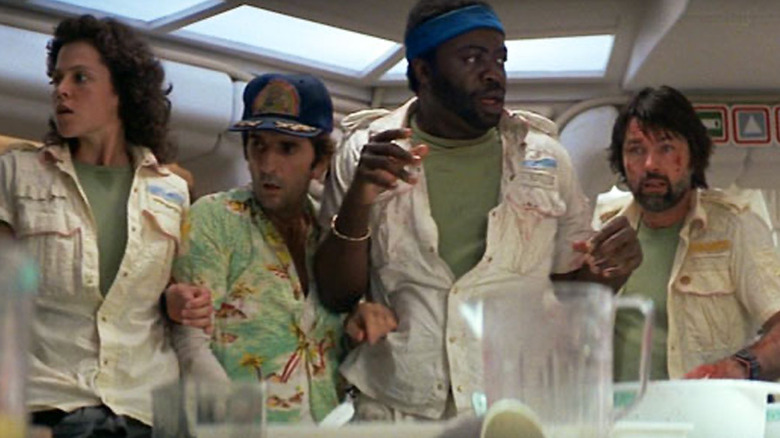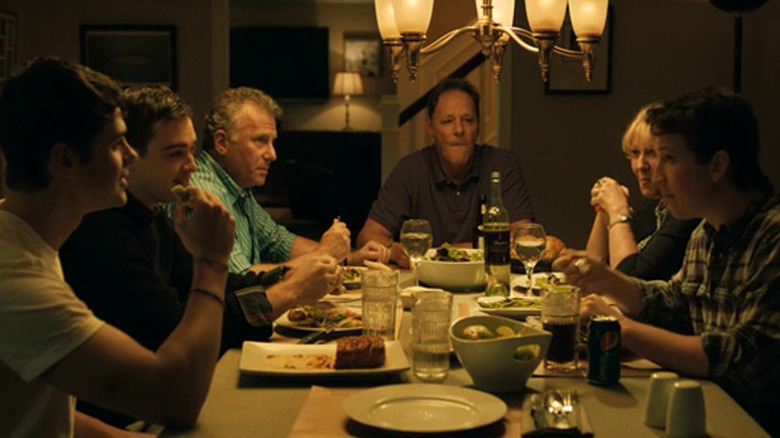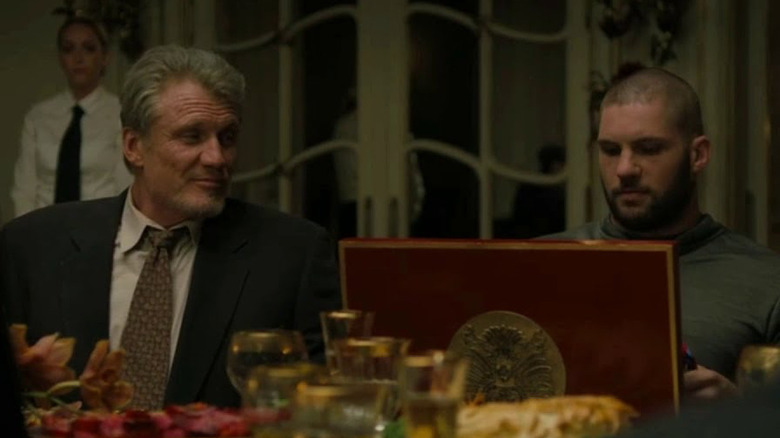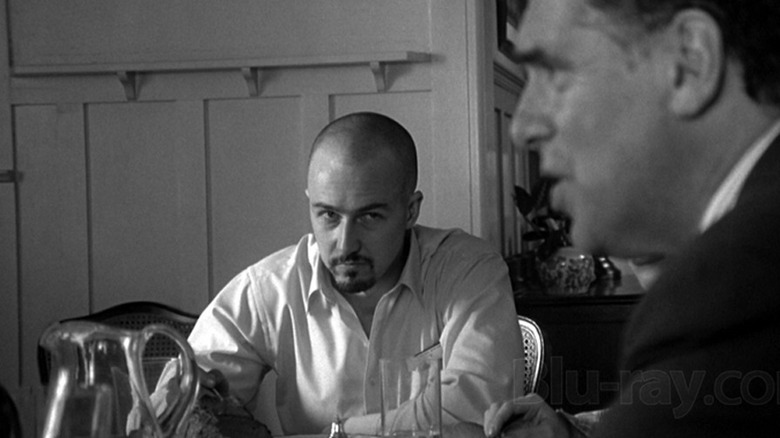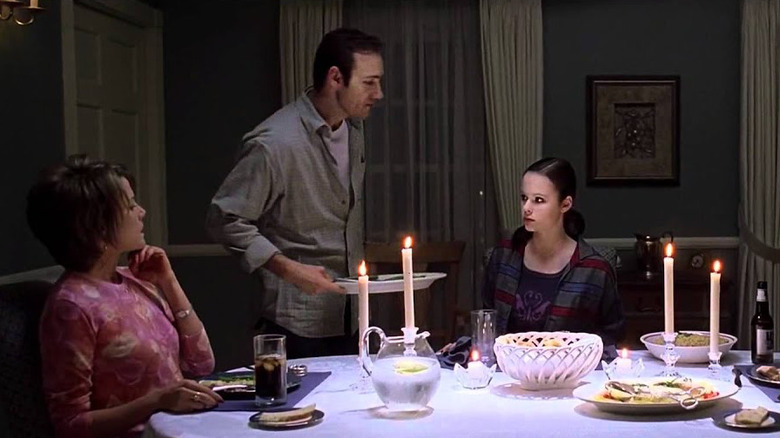Most Intense Dinner Scenes In Movie History
In the world of cinema, there is perhaps no recurring trope more valuable than the dinner scene. Be it sinister grindhouse classics or hilarious animated movies, dinner scenes have been a recurring device in various cinematic outings.
Why? There are a few different reasons, the first being that it's a chance for various characters to interact. Truly, a sit-down meal can provide the perfect venue for both awkward conversations and dramatic moments of onscreen catharsis. Not only that, but the scene can also serve as a great way to introduce and reintroduce characters into the narrative. The trope is so ubiquitous that everyone from Quentin Tarantino to Martin Scorcese have used them, often to masterful effect. Some films see the value of a dinner scene so much that they hinge the entire plot on it, as seen in "My Dinner with Andre." Here are just a few noteworthy examples of onscreen dinners that resulted in intense laughter or intense discomfort.
Goodfellas
If you go through Martin Scorcese's entire filmography, you are quite likely to discover several recurring tropes throughout his projects. One such trope is the inclusion of food, be it his various dinner scenes or scenes of dialogue focused around food. "Goodfellas" is often regarded as Scorcese's strongest film, which is saying a lot, considering his stellar cinematic track record. Based on the book "Wiseguys" by Nicholas Pileggi, the film follows aspiring mobster Henry Hill and his rise to the top. Henry starts at the very bottom, and as the film progresses, we see him graduate from petty theft to legitimate mobster business.
Partway through the film, Billy Batts insults Henry's friend Tommy DeVito at Henry's own nightclub, resulting in Billy being beaten and shot to death. They proceed to load his body into the trunk of the car and, en route to upstate New York, stop off at the house of Tommy's mother. What ensues is an impromptu Italian dinner that sees the fellas casually enjoying pasta while a dead body sits in the car trunk outside. The scene is only heightened when you know that Tommy's mother is played by none other than Martin Scorcese's own mother, Catherine.
The Texas Chainsaw Massacre
In the annals of horror history, there are few films as celebrated as the original "Texas Chainsaw Massacre." From its chilling sense of realism to its horrific sound design, the film is still disturbing even decades later. The film is noteworthy for introducing the world of cinema to the menacing Leatherface, a lumbering psychopath with a penchant for human skin. In the original film, Sally Hardesty and her friends cross paths with the sadistic Sawyer family while out for a drive. This leads to all Sally's friends — including her wheelchair-using brother Franklin — being brutally butchered by Leatherface and his family.
Eventually, Sally awakens to find herself tied to a chair at the mercy of the Sawyers during their "family dinner." Much to the horror of poor Sally, the dinner consists of human flesh and organs, causing her to scream in terror. The scene is elevated by an intense sequence of closeups on Sally's tearful bloodshot eyes as the Sawyers mock her cries. Much like the film as a whole, what the scene lacks in budget, it more than makes for in legitimate unease and terror. It's not just any disturbing dinner scene, either — it's still widely regarded as one of cinema's scariest sequences.
Hereditary
Modern horror has seen a huge uptick in recent years thanks to films that have been pushing the envelope both visually and thematically. One example of this elevated horror trend is the 2018 horror-drama "Hereditary" directed by the then-debuting Ari Aster. Going back as far as his college films — "The Strange Thing About the Johnsons" and "Munchausen" — Aster has always found interest in disturbing family dynamics. "Hereditary" definitely takes that interest to its most logical and horrific conclusions as we are introduced to Annie Graham and her family. The family, following the loss of Annie's controlling mother, experiences another tragic loss in the form of their young daughter Charlie.
While with her older brother Peter at a party, Charlie is exposed to peanuts, which she is deathly allergic to. While driving home in a hurry, Peter swerves past a telephone pole that takes Charlie's head clean off. Following her death, the whole family is sent into a deep depression (especially Peter, who is somewhat to blame). This leads to a truly morose and ungodly awkward dinner scene where Peter makes an attempt to talk to his mother. But Annie, grief-stricken and having absolutely none of it, begins verbally tearing into Peter for what he's done. It's gut-wrenching, uncomfortable, and emotionally draining — in short, it's everything that Ari Aster does best in just one scene.
Eraserhead
When you say the name David Lynch, you might begin conjuring mental images of surreal and mind-bending visuals. This is perhaps best represented in his 1977 cult classic "Eraserhead," which was actually his first cinematic effort. The film centers around Henry Spencer, who lives in a decrepit apartment building in a dissipated industrial area. In this apartment building resides his girlfriend Mary X and her family, who invite Henry over for dinner.
Henry arrives and, in now-typical Lynch fashion, things get very strange in record time — especially when it comes to the food. After attempting conversation with Mary's bizarre mother, Henry is presented with a chicken that was made by Mary's father. The chicken, man-made in its appearance, begins convulsing and spurting what appears to be a blood-like substance. After dinner, Henry is talking to Mary's mother who — after trying to kiss him — informs him that Mary has given birth to his child. This child is revealed to be an inhuman monstrosity with a grotesque animal-like face who cries endlessly throughout the night. Nothing beats sitting down with your partner's family for the first time for a hearty home-cooked meal, though we can safely assume that none of you have had a dinner as icky and uncomfortable as this one.
Django Unchained
When it comes to on-screen intensity, very few directors excel in the area like Quentin Tarantino. When you watch a Tarantino movie, you are guaranteed a lengthy film packed to the brim with sharp dialogue and, very often, excessive violence. "Django Unchained" is no different, and it's Tarantino's ode to the Spaghetti Western genre made popular by the likes of Sergio Leone.
Django Freeman is an enslaved person who is recruited by Dr. King Shultz and brought into the bounty hunting business. Their successful bounty hunting streak takes them all the way to Mississippi with the goal of saving Django's wife, Broomhilda. This hunt leads them to Candyland, a plantation run by the suave yet sadistic "Monsieur" Calvin J. Candie. Amidst their ruse of conducting a business transaction with Calvin to acquire her, their cover is blown just in time for dinner. This leads to a suspenseful scene where Calvin chillingly shows off the skull of a dead enslaved person and proceeds to smash it. It's worth noting that Calvin cutting himself was actually a botch by DiCaprio, who legitimately sliced his hand open. This is an example of a scene where an accidental injury might've actually enhanced the final product.
Shrek 2
If ever there was an animated franchise that's beloved by kids and adults alike, it's the "Shrek" movies. From their colorful animation to legitimately clever writing and pop culture references, it isn't hard to see why the series caught on. For many fans, "Shrek 2" is seen as the high mark of the series — the film takes everything that made the first film great and dials it up to 11, leading to maximum hilarity. The story follows the recently married Shrek and Fiona, who travel to the Kingdom of Far Away to see Fiona's parents.
Harold and Lillian are shocked to see that their daughter, still an ogre, has actually married one, making for an awkward reunion. What ensues is almost a comedic take on the film "Guess Who's Coming to Dinner," but with Shrek in place of Sidney Poitier. This leads to a dinner scene between the two couples (with Donkey included) that is equal parts awkward and hilarious. Shrek and Harold, amidst a conversation about the possibility of grandchildren, quickly descend into an argument of passive-aggressive comments. The film concludes with an airborne roast pig that serves as the cherry on top of a hysterical sequence.
Inglourious Basterds
Is it possible for your heart to be relocated to your throat for the entirety of a film scene? While "Inglourious Basterds" is one of Tarantino's patchier outings thanks to its bizarre pacing and structure, it's still an exemplary film. The film contains several powerhouse scenes — from the suspenseful opening to the introduction of the Bear Jew to the cathartic climax. One such scene just so happens to be one of cinema's most terrifying sit-down meals ever captured on film. The scene focuses on Shoshanna, a Jewish woman masquerading as Emmanuelle, a French cinema entrepreneur who has been invited to dine with German sniper Fredrick Zoller.
During the meal, Shosanna is not only introduced to Joseph Goebbels but also reintroduced to a haunting face from her past — SS Colonel Hans Landa, a renowned German detective who is dubbed "the Jew Hunter" for his penchant for catching Jewish people. Considering that Landa is the man who found and slaughtered her entire family, this is the last place Shosanna wants to be. Landa essentially interviews her over a plate of strudel, complete with creme, which makes for a lengthy and uncomfortable segment. In a film already chock full of powerhouse scenes and performances, this section stands out as particularly riveting.
Alien
At its core, the first "Alien" film (directed by Ridley Scott) is a haunted house film in space. The movie sees the crew of the spacecraft Nostromo, a commercial towing vehicle, awoken from their stasis by a distress call. This call leads them to a crashed ship that carries a diseased alien creature and strange eggs. One of the crewmembers, Kane (John Hurt), encounters one of these eggs and is suddenly attacked by an alien lifeform. This parasitic entity attaches itself to Kane's face before crawling off and dying on its own.
All seems fine until the crew convenes for dinner, and amidst the meal, Kane begins convulsing wildly on the table. Suddenly, an alien creature — later classified as a Xenomorph — erupts out of Kane's chest in a burst of sickening gore. It's a scene that has become so famous that almost everyone from Mel Brooks to "The Simpsons" has parodied it. Even 40 years later, both the film and this scene succeed at captivating and terrifying viewers in droves. We've all had trouble keeping our food down at dinner before, but nothing to the extent of this meal on the doomed Nostromo.
Whiplash
If you've ever been the only one in your family to pursue the arts, there's a good chance you've had this dinner. Released in 2014, "Whiplash" would prove to be the breakout film for director Damien Chazelle, who later directed "La La Land." The film centers around Andrew Neiman, a first-year drumming student at Shaffer Conservatory in NYC who is one day recruited by Terence Fletcher. Fletcher conducts for the Shaffer Conservatory Studio Band and very quickly begins putting poor Andrew through absolute hell. But Andrew, despite increasing fatigue and mental burnout, is willing to persevere in pursuit of his dream of musical greatness.
This dream is made clearer to the viewer when Andrew sits down for dinner with his dad and his uncle's family. Despite his musical achievements getting mild lip service, all attention is immediately diverted to his uncle's sons — both in football and model UN, respectively. This leads to some rather passive-aggressive back and forth comments between Andrew and his relatives as he defends his chosen passion. By the end of the scene, Andrew is so fed up that he opts to walk away from the table in silence. Much like the rest of the film, it's a harsh and realistic scene that shows the ugly side of artistic endeavors.
Creed II
The "Creed" films make for a simple but emotionally resonant and intense double feature, especially if you are a big "Rocky" fan. The sequel not only serves as a direct continuation of the first film but also as a follow-up to the events of "Rocky IV." The sequel sees the return of Rocky's old foe Ivan Drago, who introduces the boxing world to his son Viktor. Viktor is just as devastating a powerhouse in the ring as his father was, and he proves so to Adonis Creed in their first match.
After nearly putting Adonis six feet deep in their first encounter, Viktor and Drago are invited to a fancy dinner with various Russian delegates. This is welcome attention for Ivan, who was reduced to a laughingstock following his now legendary loss to Rocky in the '80s. However, one of these guests just so happens to be Ivan's ex-wife Ludmilla, the sight of which immediately repels Viktor. Viktor, showing legitimate discomfort for the first time in the entire film, lambasts his father for caring about the people who abandoned them. "Creed II" boasts intense action as well as several emotionally supercharged scenes, with this being a prominent example.
American History X
In terms of expertly crafted films that are hard to rewatch, "American History X" is high on the list. The film concerns Danny, who is following in the problematic footsteps of his older brother Derek (Edward Norton) by becoming a neo-Nazi.
"American History X" is the brainchild of David McKenna, who noted in a ForenSeek interview that the film's events are partially inspired by his own youth. One of the important things the film chooses to depict is how people wind up embracing hateful ideologies. This is shown most effectively in two scenes — a breakfast and dinner segment, both of which show the before and after of bigoted influence.
In the dinner scene, we see a grown Derek expounding on his misguided views concerning the Los Angeles riots. This results in a brutal family argument that concludes when Derek lays his hands on his sister Davina. This is counterpointed later when we see a flashback depicting a younger Derek at breakfast, once again with his family. Here, his father rants about his own misguided ideology in regards to the African American literature Derek is reading at school. Placing the scenes in this order is quite effective as it shows just how an impressionable mind can be indoctrinated into bigotry.
American Beauty
Only in a film as bizarre as "American Beauty" could someone asking their wife to pass the asparagus be simultaneously tense and hilarious. The film concerns Lester, a middle-aged father who spirals into a self-destructive midlife crisis after falling in love with his daughter's best friend. This quest for self-fulfillment results in Lester quitting his job and blackmailing his boss into giving him a sizable severance package.
This is a major source of tension between Lester and his overly neurotic wife Carolyn, who viciously drags him over it during dinner. Lester is still over the moon about his actions and continues to defend them — continually requesting that someone pass the asparagus. This is all in front of their daughter Jane, who watches in bewildered silence. The scene concludes with Lester taking the asparagus and tossing it right at the wall, much to the shock of Carolyn and Jane. It's a joyously awkward scene that is as intense as it is hilarious.
